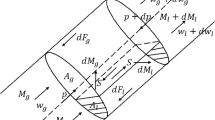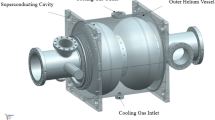Abstract
Purpose
In recent years, with the further development of superconducting technology, superconducting devices have been applied in particle accelerators and synchrotron radiation light source devices. As a new type of heat transfer structure, helium cryogenic oscillating heat pipe can be used to balance local hot spots in superconductors and improve heat transfer performance.
Methods
In this paper, a two- dimensional two-turns helium cryogenic oscillating heat pipe model is established. The flow performance of helium cryogenic oscillating heat pipe was analyzed by CFD simulation.
Results and conclusion
The results show that the development of flow pattern in the helium cryogenic oscillating heat pipe first forms bubble flow under the heating of the evaporation section, and then gradually forms slug flow and annular flow. The process consists of initial stage, transition stage and running stage. In the running stage, the effective thermal conductivity of COHP oscillates around 15,000 W/(m·K).










Similar content being viewed by others
Abbreviations
- F :
-
Wall friction (N/m2)
- G :
-
Mass source term due to phase change (kg/m3·s)
- α :
-
Volume fraction (−)
- ρ :
-
Density (kg/m3)
- con:
-
Condensation
- eva:
-
Evaporation
- g :
-
Gas
- l :
-
Liquid
References
H.K. Onnes. The resistance of pure mercury at helium temperature. Leiden Comm, 122b, (1911)
S.A. Gourlay, Superconducting accelerator magnet technology in the 21st century: A new paradigm on the horizon? Nucl. Inst. Methods Phys. Res. A 893, 124–137 (2018)
Z. Haifeng, Y. Haifeng, D. Huaikuang, Cryogenic technology for small and medium sized low temperature superconducting magnet. Cryo. Supercond. 45(7), 24–28 (2017)
L. Benkheira, B. Baudouy, M. Souha, Heat transfer characteristics of two-phase He I (4.2 K) thermosiphon flow. Heat Mass Transf. 50, 3534–3544 (2007)
Z. Zong, Cryogenic processes of SuperKEKB superconducting magnet cryostat with continuous flow of saturated liquid helium. Appl. Therm. Eng. (2022). https://doi.org/10.1016/j.applthermaleng.2022.119349
Z. Baotang, W. Meifen, W. Heng, Experimental study of a small-sized He I thermosyphon for the detector superconducting magnet of the CEPC, Cryo. & Supercond. Vol. 45 No. 11
H. Akachi, Structure of a heat pipe. Kanagawa. US Patent 4921041, (1990)
Xu. Dong, L. Li, H. Liu, Experimental investigation on the thermal performance of helium based cryogenic pulsating heat pipe. Exp. Therm. Fluid Sci. 70, 61–68 (2016)
T. Mito, K. Natsume, N. Yanagi et al., Achievement of high heat removal characteristics of superconducting magnets with imbedded oscillating heat pipes. IEEE Trans. Appl. Supercond. (2011). https://doi.org/10.1109/TASC.2010.2100356
Q. Liang, Yi. Li, Q. Wang, Experimental investigation on the performance of a neon cryogenic oscillating heat pipe. Cryogenics 84, 7–12 (2017)
A.J. Jiao, H.B. Ma, J.K. Critser, Experimental investigation of cryogenic oscillating heat pipes. Int. J. Heat Mass Transf. 52(15–16), 3504–3509 (2009)
D. Haoren, S. Xiao, H. Dongyagn et al. Experimental study on pulsating heat pipe in liquid hydrogen temperature zone. Cryogenics 209(1), 6–10+42 (2016)
D.Y. Han, X. Sun, Z.H. Gan et al., Numerical investigation on pulsating heat pipes with nitrogen or hydrogen. Mater Sci Eng (2017). https://doi.org/10.1088/1757-899X/278/1/012056
Xu. Jinzhu, J. Bo, S. Xiao et al., Computational fluid dynamics (CFD) simulation of single loop pulsating heat pipe at high liquid filling rate in liquid hydrogen temperature range. Chem Ind Eng Progr 39(07), 2556–2565 (2020)
K.R. Sagar, H.B. Naik, H.B. Mehta, Numerical study of liquid nitrogen based pulsating heat pipe for cooling superconductors. Int. J. Refrig. 122, 33–46 (2021)
X. Liu, Y. Hao, Numerical simulation of vapor-liquid two-phase flow in a closed loop oscillating heat pipe, in Proceedings of the ASME 2009 International Mechanical Engineering Congress & Exposition IMECE2009, November 13–19, Lake Buena Vista, Florida, USA.
J.U. Brackbill, D.B. Kothe, C. Zemach, A continuum method for modeling surface tension. J. Comput. Phys. 100(2), 335–354 (1991)
W.H. Lee, R.W. Lyczkowski, The basic character of five two-phase flow model equation sets. Int. J. Numer. Meth. Fluids 33(8), 1075–1098 (2000)
C. Baldassari, M. Marengo, Flow boiling in microchannels and microgravity. Progr. Energy Combust. 39, 1–36 (2013)
Acknowledgements
This work was supported by National Natural Science Foundation of China (No. 11905233).
Author information
Authors and Affiliations
Corresponding author
Ethics declarations
Conflict of interest
The author(s) declares that there is no potential conflict of interest with respect to the research, authorship, and/or publication of this article.
Rights and permissions
Springer Nature or its licensor (e.g. a society or other partner) holds exclusive rights to this article under a publishing agreement with the author(s) or other rightsholder(s); author self-archiving of the accepted manuscript version of this article is solely governed by the terms of such publishing agreement and applicable law.
About this article
Cite this article
Huo, Y., Ma, C., Zhang, J. et al. Simulation study on thermal performance of two turns helium cryogenic oscillating heat pipe for superconducting accelerator. Radiat Detect Technol Methods 7, 427–434 (2023). https://doi.org/10.1007/s41605-023-00403-2
Received:
Revised:
Accepted:
Published:
Issue Date:
DOI: https://doi.org/10.1007/s41605-023-00403-2




